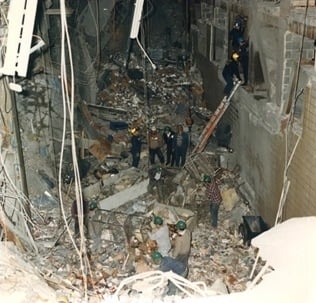February 26, 1993 – A bomb explodes in the parking garage beneath the World Trade Center in New York City. Six people died and 1,000 were injured by the powerful blast. The buildings themselves, once the world’s tallest, were nearly toppled by the bomb; an underground restraining wall came precariously close to breaking and allowing the Hudson River to spill into the World Trade Center’s support area. Hours after the explosion, an informant identified a group of Serbians in New York as the culprits. However, when the FBI conducted surveillance of the gang they found not terrorists but jewel thieves, putting an end to a major diamond-laundering operation. Fortunately, investigators at the bomb scene found a 300-pound section of a van frame that had been at the center of the blast. The van’s vehicle identification number was still visible, leading detectives to the Ryder Rental Agency in Jersey City, New Jersey. Their records indicated that Mohammed Salameh had rented the van and reported it stolen on February 25. Salameh was already in the FBI’s database as a potential terrorist, so agents knew that they had probably found their man. Salameh compounded his mistake by insisting that Ryder return his $400 deposit. When he returned to collect it, the FBI arrested him. A search of his home and records led to two other suspects. Meanwhile, the owner of a storage facility in Jersey City came forward to say that he had seen four men loading a Ryder van on February 25. When this storage space was checked, they found enough chemicals, including very unstable nitroglycerin, to make another massive bomb. Investigators also found videotapes with instructions on bomb making that led to the arrest of a fourth suspect. Other evidence showed that one of the terrorists had bought hydrogen tanks from AGL Welding Supply in New Jersey. In the wreckage under the World Trade Center, three tanks marked “AGL Welding” were found. In addition, the terrorists had sent a letter to the New York Times claiming responsibility for the blast. Portions of this letter were found on the hard drive of one of the suspect’s computers. Finally, DNA analysis of saliva on the envelope matched that of the suspect. The wealth of evidence resulted in easy convictions, and each of the men was sentenced to 240 years in prison. Despite the fact that the terrorists did not succeed in destroying the World Trade Center, the bombing remains one of the worst acts of foreign terrorism on U.S. soil.
February 26, 1993 – A bomb explodes in the parking garage beneath the World Trade Center in New York City. Six people died and 1,000 were injured by the powerful blast. The buildings themselves, once the world’s tallest, were nearly toppled by the bomb; an underground restraining wall came precariously close to breaking and allowing the Hudson River to spill into the World Trade Center’s support area. Hours after the explosion, an informant identified a group of Serbians in New York as the culprits. However, when the FBI conducted surveillance of the gang they found not terrorists but jewel thieves, putting an end to a major diamond-laundering operation. Fortunately, investigators at the bomb scene found a 300-pound section of a van frame that had been at the center of the blast. The van’s vehicle identification number was still visible, leading detectives to the Ryder Rental Agency in Jersey City, New Jersey. Their records indicated that Mohammed Salameh had rented the van and reported it stolen on February 25. Salameh was already in the FBI’s database as a potential terrorist, so agents knew that they had probably found their man. Salameh compounded his mistake by insisting that Ryder return his $400 deposit. When he returned to collect it, the FBI arrested him. A search of his home and records led to two other suspects. Meanwhile, the owner of a storage facility in Jersey City came forward to say that he had seen four men loading a Ryder van on February 25. When this storage space was checked, they found enough chemicals, including very unstable nitroglycerin, to make another massive bomb. Investigators also found videotapes with instructions on bomb making that led to the arrest of a fourth suspect. Other evidence showed that one of the terrorists had bought hydrogen tanks from AGL Welding Supply in New Jersey. In the wreckage under the World Trade Center, three tanks marked “AGL Welding” were found. In addition, the terrorists had sent a letter to the New York Times claiming responsibility for the blast. Portions of this letter were found on the hard drive of one of the suspect’s computers. Finally, DNA analysis of saliva on the envelope matched that of the suspect. The wealth of evidence resulted in easy convictions, and each of the men was sentenced to 240 years in prison. Despite the fact that the terrorists did not succeed in destroying the World Trade Center, the bombing remains one of the worst acts of foreign terrorism on U.S. soil.
0 Comments
0 Shares
4K Views




